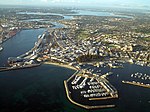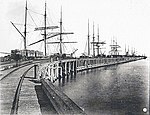North Mole Lighthouse

The North Mole Lighthouse began operation in 1906 at the entrance to Fremantle Harbour, in Western Australia. The occulting red light, emitted from a fixed lightsource at a focal plane height of 15 metres (49 ft) above sea level, is visible for 11 miles (18 km) and indicates the westernmost point of the harbour and its entrance. The lighthouse established permanent service from 1906; after the mole's foundations had settled a temporary lighting arrangement there was discharged. The light originally planned for the house was found to be too powerful and was sent to Broome for the steel lighthouse at Gantheume Point. The lighthouse and its technically identical yet green coloured partner on the south mole are the last remaining of their type. It has an 'indicative place' status of the Register of the National Estate and is a well-known landmark to seamen visiting the port. It was designed by Charles Yelverton O'Connor, an engineer responsible for the construction of Fremantle Harbour and who advanced the proposal of the Goldfields Water Supply Scheme. The 15 m tower is made of cast iron, painted red and features classical decorations. It is located at the end of North Mole Drive. The position is a well used recreational fishing spot and a vantage point for ocean yacht racing or birdwatching. In June in 1927 and July 1935, severe storms were recorded affecting the Moles but not seriously damaging the lighthouses.
Excerpt from the Wikipedia article North Mole Lighthouse (License: CC BY-SA 3.0, Authors, Images).North Mole Lighthouse
North Mole Drive,
Geographical coordinates (GPS) Address Nearby Places Show on map
Geographical coordinates (GPS)
| Latitude | Longitude |
|---|---|
| N -32.053888888889 ° | E 115.72452777778 ° |
Address
North Mole
North Mole Drive
6959 , North Fremantle
Western Australia, Australia
Open on Google Maps









